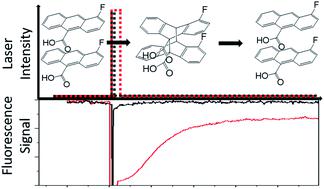当前位置:
X-MOL 学术
›
Chem. Sci.
›
论文详情
Our official English website, www.x-mol.net, welcomes your
feedback! (Note: you will need to create a separate account there.)
Using light intensity to control reaction kinetics and reversibility in photomechanical crystals
Chemical Science ( IF 7.6 ) Pub Date : 2020-08-21 , DOI: 10.1039/d0sc03557b Connor J. Easley 1, 2, 3, 4 , Fei Tong 1, 2, 3, 4 , Xinning Dong 1, 2, 3, 4 , Rabih O. Al-Kaysi 5, 6, 7, 8, 9 , Christopher J. Bardeen 1, 2, 3, 4
Chemical Science ( IF 7.6 ) Pub Date : 2020-08-21 , DOI: 10.1039/d0sc03557b Connor J. Easley 1, 2, 3, 4 , Fei Tong 1, 2, 3, 4 , Xinning Dong 1, 2, 3, 4 , Rabih O. Al-Kaysi 5, 6, 7, 8, 9 , Christopher J. Bardeen 1, 2, 3, 4
Affiliation

|
4-Fluoro-9-anthracenecarboxylic acid (4F-9AC) is a thermally reversible (T-type) photomechanical molecular crystal. The photomechanical response is driven by a [4 + 4] photodimerization reaction, while the photodimer dissociation determines the reset time. In this paper, both the chemical kinetics of dimer dissociation (using a microscopic fluorescence-recovery-after-photobleaching experiment) and mechanical reset dynamics (by imaging bending microneedles) for single 4F-9AC crystals are measured. The dissociation kinetics depend strongly on the initial concentration of photodimer, slowing down and becoming nonexponential at high dimer concentrations. This dose-dependent behavior is also observed in the mechanical response of bending microneedles. A new feature in the photomechanical behavior is identified: the ability of a very weak control beam to suppress dimer dissociation after large initial dimer conversions. This phenomenon provides a way to optically control the mechanical response of this photomechanical crystal. To gain physical insight into the origin of the nonexponential recovery curves, the experimental results are analyzed in terms of a standard first-order kinetic model and a nonlinear Finke–Watzky (FW) model. The FW model can qualitatively reproduce the transition from exponential to sigmoidal recovery with larger initial conversions, but neither model can reproduce the suppression of the recovery in the presence of a weak holding beam. These results highlight the need for more sophisticated theories to describe cooperative phenomena in solid-state crystalline reactions, as well as demonstrating how this behavior could lead to new properties and/or improved performance in photomechanical materials.
中文翻译:

使用光强度控制光机械晶体的反应动力学和可逆性
4-氟-9-蒽羧酸(4F-9AC)是一种热可逆(T型)光机械分子晶体。光机械响应由[4 + 4]光二聚反应驱动,而光二聚体的解离决定了复位时间。在本文中,针对单个4F-9AC的二聚体解离的化学动力学(使用光漂白后的显微荧光恢复后的微观化学动力学)和机械复位动力学(通过弯曲微针成像)测量晶体。解离动力学在很大程度上取决于光二聚体的初始浓度,减慢并在高二聚体浓度下变为非指数。在弯曲的微针的机械响应中也观察到这种剂量依赖性行为。确定了光机械行为的一个新功能:非常弱的控制光束抑制大量初始二聚体转化后的二聚体解离的能力。这种现象提供了一种光学控制该光机械晶体的机械响应的方法。为了深入了解非指数恢复曲线的起源,我们根据标准的一阶动力学模型和非线性Finke-Watzky(FW)模型对实验结果进行了分析。FW模型可以定性地再现具有较大初始转换的从指数恢复到S形恢复的过渡,但是在保持束弱的情况下,这两个模型都不能再现对恢复的抑制。这些结果表明,需要更复杂的理论来描述固态晶体反应中的合作现象,并证明这种行为如何导致光机械材料的新性能和/或性能改善。
更新日期:2020-09-23
中文翻译:

使用光强度控制光机械晶体的反应动力学和可逆性
4-氟-9-蒽羧酸(4F-9AC)是一种热可逆(T型)光机械分子晶体。光机械响应由[4 + 4]光二聚反应驱动,而光二聚体的解离决定了复位时间。在本文中,针对单个4F-9AC的二聚体解离的化学动力学(使用光漂白后的显微荧光恢复后的微观化学动力学)和机械复位动力学(通过弯曲微针成像)测量晶体。解离动力学在很大程度上取决于光二聚体的初始浓度,减慢并在高二聚体浓度下变为非指数。在弯曲的微针的机械响应中也观察到这种剂量依赖性行为。确定了光机械行为的一个新功能:非常弱的控制光束抑制大量初始二聚体转化后的二聚体解离的能力。这种现象提供了一种光学控制该光机械晶体的机械响应的方法。为了深入了解非指数恢复曲线的起源,我们根据标准的一阶动力学模型和非线性Finke-Watzky(FW)模型对实验结果进行了分析。FW模型可以定性地再现具有较大初始转换的从指数恢复到S形恢复的过渡,但是在保持束弱的情况下,这两个模型都不能再现对恢复的抑制。这些结果表明,需要更复杂的理论来描述固态晶体反应中的合作现象,并证明这种行为如何导致光机械材料的新性能和/或性能改善。











































 京公网安备 11010802027423号
京公网安备 11010802027423号